From inflation to injections: how governments can use cloud technology to provide real-time insights
In the face of unprecedented pressure on the economy and public services, governments around the globe are looking for ways to improve the information decision-makers have so they can make sure that policies keep pace in a fast moving world.
This is why many are using cloud technology to exploit real-time data – to both monitor the effectiveness of government interventions and provide early insight of where and when more action needs to be taken.
Recent examples in the UK public sector range from developing plans to use a wide range of pricing data to track the real inflation rates faced by different groups across the country, to monitoring public support for COVID-19 vaccines.
This article explores where the UK government is turning to cloud and the benefits from using more real-time data in their decisions.
A need for greater insights
In order to be able to understand and anticipate how public services will be affected by growing global uncertainty, the government needs to be able to obtain more up-to-date information than traditional data sources have provided.
This means using cloud technology to bring together a wider range of data across multiple indicators, and providing quicker access to the available information. This allows government departments and agencies to act in quicker and more effective ways.
To be able to take action, government needs to both develop a single source of intelligence – without which there’s a higher risk for inconsistencies across multiple sources, which can slow decision-making at critical times – and to put in place agile approaches to harness data.
By moving to the cloud, government bodies can collect and share real-time operational data across locations and departments in a more efficient way, and ensure that everyone is using the same information to inform their actions. They can also create dashboards that consolidate and present real-time data in ways that can be acted on.
On track with the cloud
Examples of this in action in the UK government include when CTS, one of Google Cloud’s leading partners, worked with the Department of Transport (DfT) to move the UK rail industry’s famous operating bible LENNON into the cloud.
LENNON stands for Latest Earnings Networked Nationally Overnight, and is an application used by the rail industry to provide daily data on ticket sales and rail franchise earnings. This information is used by both industry and government to understand how the rail network is operating.
However, the DfT was not able to make best use of this trove of data due to technological limitations, leaving it dependent on others to answer queries for them.
So the DfT worked with CTS to move the 100 terabyte system into the cloud, unlocking real benefits in the department’s understanding of what is happening over the nation’s thousands of miles of rail track.
According to the department, processing speeds have fallen dramatically – where it used to take hours to execute a query, it is now taking less than 20 seconds. And the department’s rail technical and data management team is no longer dependent on the Rail Delivery Group’s version of LENNON to run some queries.
As DfT chief architect Mark Lyons said, the collaboration between the department, Google and CTS has also created a process that can be re-used for other data processing and analysis requirements across the wider department.
Data-driven decision-making
And it is not just on the railways where real time data is of real value. At a time of rising inflation, government needs to know how much prices are rising by – and how different groups are affected – to better inform its response.
However, this has often been difficult to do. Traditional inflation figures were produced with a lag of weeks, by which time the real figure may have changed significantly. Also, headline figures do not show the impact of different population groups. The prices of goods purchased by people with lower incomes, may be rising faster than the average basket of someone better off, for example – information that might lead to a different policy response.
This is why the Office for National Statistics (ONS) is working to produce “more robust, timely and granular consumer price statistics for businesses, individuals and government”, including a project to use data from shops to provide a real-time look at how prices are changing.
This approach is transformative, allowing government to understand where and when prices are rising in a more detailed and timely way, and is made possible by using cloud technology to collect and share real-time data.
Shot in the arm
Another area where up-to-the-minute data is a premium in policymaking is public attitudes to coronavirus vaccinations. Once it became apparent that vaccines could be developed to fight COVID-19, officials needed to know if citizens would be willing to have the injection. This is where the Cabinet Office’s vaccine sentiment analysis came in, measuring reluctance to vaccines and then, crucially, being able to track changes as government campaigns to promote inoculation were implemented.
As well as providing insight for the UK’s own vaccine campaign, which has been heralded for its effective rollout, the project also informed the Global Vaccine Confidence Summit – hosted as part of the UK’s G7 presidency – where a coalition of governments and companies pledged to maintain a digital insight platform to provide trends on vaccine confidence and the harmful misinformation that is seeking to undermine it.
Making sense of delivering the Census
Cloud technology is also helping in one of the biggest data challenges regularly faced by government – conducting the national Census. The Census Cloud Platform had to handle a peak of 60,000 submissions in a 10-minute period at near lunchtime on Census Day, as well as the 36,000-strong field force gathering responses. And then there was the need to handle requests for information coming through to the website, which at one point topped 30,000 per second. According to Pete Benton, the deputy national statistician for health, population and methods at ONS, this wasn’t a problem because building the system in the cloud enabled it “to scale naturally and easily”.
“We worked with the cloud providers to make sure that we understood how to make things dynamically scale according to the numbers of users, and it worked absolutely seamlessly,” Benton told the ONS’s Statistically Speaking podcast looking at how the Census was delivered. “You can imagine there were a few people biting their nails in the days running up to it, with something quite that big, but on the day it went without a blink.”
Again, the availability of real-time insight proved key. “We had real-time dashboards telling us both how many people were on our website and how many were completing the questionnaire at any given point in time, and you genuinely could see spikes where the number of people on our website jumped fivefold in a particular minute when the Census was mentioned on Gogglebox. And you saw peaks when the Census was talked about in EastEnders and on The One Show and BBC News, and then when the TV advert went out on the Saturday night before Census Day.”
Unlocking understanding
These examples provide an overview of how government decision-making can be made more effective by embracing the use of cloud technology, and how it can provide a minute-by-minute update of key government services or projects.
Implementing these technologies and solutions can come with their challenges and, particularly, it is understandable that any headway towards full cloud adoption slowed down amid the pressures of the COVID-19 response.
But there is insight to be gained if the government can adopt modern IT infrastructure. From having the insights to take the right economic measures to knowing if people are hesitant to take up vaccines, providing the right information – in real time and at any given time – is crucial to make sure governments can respond to the frequent crises in an uncertain world.
Find out more about how government can use real time data by joining Global Government Forum’s upcoming webinar in association with CTS. Getting real: how real time data can improve government services will share insights from across government on how data can be used to unlock insights that can improve both policy development and the delivery of public services.

















